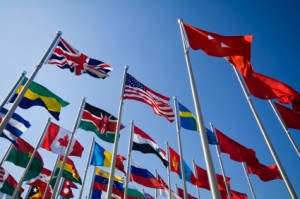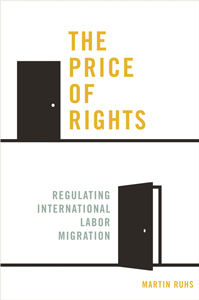In 1990, the General Assembly of the United
 Nations (UN) adopted the International Convention on the Protection of the Rights of All Migrant Workers and Members of Their Families (CMW). It stipulates a very comprehensive set of civil, political, economic, and social rights for migrants, including those living and/or working abroad illegally. Hailed as a major achievement in the struggle for improving the rights of migrants, the CMW has become a cornerstone of the human rights–based approach to regulating labour immigration advocated by many national and international organisations concerned with the protection of migrant workers.
Nations (UN) adopted the International Convention on the Protection of the Rights of All Migrant Workers and Members of Their Families (CMW). It stipulates a very comprehensive set of civil, political, economic, and social rights for migrants, including those living and/or working abroad illegally. Hailed as a major achievement in the struggle for improving the rights of migrants, the CMW has become a cornerstone of the human rights–based approach to regulating labour immigration advocated by many national and international organisations concerned with the protection of migrant workers.
In practice, ratification of the 1990 convention has been disappointing, both in absolute and relative terms. Although the CMW was introduced more than twenty years ago, so far fewer than fifty countries have ratified it - and the great majority of these countries are predominantly migrant sending rather than migrant receiving. This makes the CMW the least ratified convention among all the major international human rights treaties. It has a quarter of the ratifications of the Convention on the Rights of the Child (passed a year before the CMW) and less than half of the ratifications of the Convention on the Rights of Persons with Disabilities (passed sixteen years after the CMW).
Despite having signed general human rights treaties, most nation-states, especially major immigration countries, are clearly reluctant to ratify international conventions that limit their discretion and ability to restrict the rights of migrants living and working in their territories.
Why have so few countries ratified the CMW? The existing literature has identified a host of legal issues and complexities as well as a lack of campaigning and awareness of the CMW and other international conventions as key factors (see, for example, the introduction in Migration and Human Rights: The United Nations Convention on Migrant Workers’ Rights, edited. P. de Guchteneire, A. Pécoud, and R. Cholewinski, Cambridge University Press, 2009)
 I argue in my new book, The Price of Rights: Regulating International Labor Migration, that the primary explanation for the low level of ratifications of international migrant rights treaties lies with the effects of granting or restricting migrant rights on the national interests (however defined) of migrant-receiving countries. This may sound like an obvious point, but the dearth of discussion about the multifaceted costs and benefits of specific migrant rights for receiving countries—and migrants and their countries of origin—suggests that this is an important gap in the analysis and debates that needs to be urgently addressed.
I argue in my new book, The Price of Rights: Regulating International Labor Migration, that the primary explanation for the low level of ratifications of international migrant rights treaties lies with the effects of granting or restricting migrant rights on the national interests (however defined) of migrant-receiving countries. This may sound like an obvious point, but the dearth of discussion about the multifaceted costs and benefits of specific migrant rights for receiving countries—and migrants and their countries of origin—suggests that this is an important gap in the analysis and debates that needs to be urgently addressed.
Migrant Rights as Instruments of Labour Immigration Policy
There is a large gap between the rights of migrant workers stipulated in international human rights law and the rights that migrants working in high-income countries experience in practice. Many UN agencies and other international and national organisations concerned with migrant workers have responded to the widespread restrictions of migrant rights by emphasizing that migrant rights are human rights that are universal, indivisible, and inalienable; they derive from a common humanity and must be protected regardless of citizenship.
A key argument and starting point of my book The Price of Rights is that we need to expand current debates and analyses of migrant rights by complementing conversations about the human rights of migrants with a systematic, dispassionate analysis of the interests and roles of nation-states in granting and restricting the rights of migrant workers. This is because the rights of migrant workers not only have intrinsic value, as underscored by human rights approaches, but also play an important instrumental role in shaping the effects of international labour migration on receiving countries, migrants, and their countries of origin.
 For example, whether or not migrants enjoy the right to free choice of employment and other employment-related rights in the receiving country’s labour market is likely to affect their productivity, earnings, remittances and competition with local workers. The fiscal effects of immigration critically depend on whether and how migrants’ social rights (including access to public services and welfare benefits) are restricted. Migrants’ incentives and behavior in and beyond the labour market—for instance, the extent to which they acquire language and other skills relevant to employment and life in the host country—will be influenced by whether or not they have—or are on a path to acquiring—the rights to permanent residence and citizenship.
For example, whether or not migrants enjoy the right to free choice of employment and other employment-related rights in the receiving country’s labour market is likely to affect their productivity, earnings, remittances and competition with local workers. The fiscal effects of immigration critically depend on whether and how migrants’ social rights (including access to public services and welfare benefits) are restricted. Migrants’ incentives and behavior in and beyond the labour market—for instance, the extent to which they acquire language and other skills relevant to employment and life in the host country—will be influenced by whether or not they have—or are on a path to acquiring—the rights to permanent residence and citizenship.
Because rights shape the effects of labour immigration, migrant rights are in practice a core component of nation-states’ labour immigration policies. At its core, the design of labour immigration policy requires simultaneous policy decisions on: how to regulate the number of migrants to be admitted (e.g. through quotas or points-based systems); how to select migrants (e.g. by skill and/or nationality); and what rights to grant migrants after admission (e.g. temporary or permanent residence; access to welfare benefits; and limited or unlimited rights to employment). When receiving countries decide on these three issues, the impacts on the “national interest” (however defined) of the existing residents in the host countries are likely to be of great significance. Policy decisions on the number, selection, and rights of migrant workers can also be influenced by their consequences for the interests of migrants and their countries of origin, whose actions and policies can play an important role in supporting, sustaining, or undermining particular labour immigration policy decisions in migrant-receiving countries.
Implications for research and policy debates
Viewing migrant rights as instruments of labour immigration policy has two key implications for research. First, any analysis of the reasons for migrant rights restrictions necessitates an explicit discussion of the economic, social, political and other consequences of migrant rights (restrictions) for the national interests of migrant-receiving and migrant-sending countries as well as for migrants themselves. These consequences can include multifaceted benefits along with costs that may vary across different rights, between the short and long run as well as between migrants with different skills. Any analysis of the costs and benefits of migrant rights thus needs to be disaggregated and needs to look at the impacts of specific rights for specific groups of migrant workers.
Second, migrant rights cannot be studied in isolation of admissions policies, both in terms of positive and normative analysis. To understand why, when, and how countries restrict the rights of migrant workers, and explore what rights migrant workers should have, we need to consider how particular rights restrictions are related to policies that regulate the admission (i.e. the numbers and selection) of migrant workers.
Do states grant skilled migrant workers more rights than low-skilled migrants, and if so, why? Are the countries that grant migrant workers near equal rights with citizens also relatively open to labour immigration, or are labour immigration policies characterized by a trade-off between openness to admitting migrant workers and some migrant rights?
These questions and the overall approach to the analysis of migrant rights as instruments of labour immigration policy are, in my view, critical to fostering a more realistic debate about the protection of migrant workers in the global labour market. The current analysis and debate of what “should be” needs to be complemented (but not replaced) by a thorough discussion of “what is.”
The Price of Rights: Regulating International Labor Migration will be published in August 2013 by Princeton University Press. The book analyzes how high-income countries restrict the rights of migrant workers as part of their labour immigration policies and discusses the implications for global debates about regulating labour migration and protecting migrants. It looks at the tensions between human rights and citizenship rights, the agency and interests of migrants and states, and the determinants and ethics of labor immigration policy.